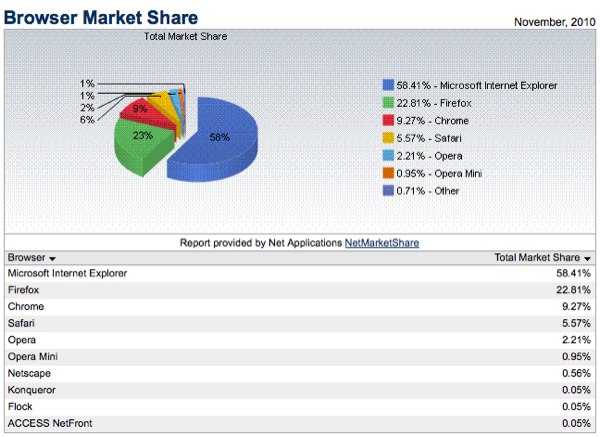In the first decade of the twenty-first century, there raged two power struggles. There were the Format Wars, which the kingdom of Blu-Ray emerged triumphant. Then, there were the Browser Wars, where the armies of Firefox, Safari and Chrome, and a little legion of Opera, invaded the realm of Internet Explorer to seize power.
Internet Explorer, which is bundled with Microsoft Windows, still retains a commanding 58% market share. Considering near the turn of the millenium, when it had started capturing most of Netscape’s users, this is a significant improvement. To be fair, Microsoft has started making Internet Explorer more secure and faster in comparison to the old standard, Internet Explorer 6. Head over to Mashable for the original infographic.
The beauty of IE7 is that it’s usable enough for the regular users to enjoy, and secure enough for them to be satisfied with. The perception is Firefox is more extensive, and Chrome is faster. There is a huge repository of themes and extensions available for Firefox, ranging from PageRank viewing tools to Hello Kitty themes. Firefox has also had a temporal advantage to Chrome, as it has had a couple of years head start to gain more users.
Google Chrome has gained attention due to its consistent updates and speed. Like Firefox, it also has the potential to be themed and extended, but Chrome has a more ‘minimalistic’ feel to it. Where Firefox has Bookmarks and places for Toolbars, extensions for Chrome are created to appear smaller and less significant. There’s less space given to forward and back buttons, and the home button is off by default. All this contributes to a very ‘streamlined’ vibe. But does Chrome have speed where it actually counts?
It’s often difficult to prove things to consumers that aren’t typically willing to listen. Why would they care? IE7 and Firefox and both working perfectly well for them. Google devised a plan to entertain their audiences while proving a point.
They enlisted a lab in Japan to arrange a set of dominos, and placed computers strategically in certain locations between the dominoes. The point is to create a seamless transition from the physical real arrangement of the dominoes, then to show a video of the dominoes falling, and then back to the real world. It’s much easier to understand when watched. 😛
The beautiful thing about this video is that it proves exactly what Google Chrome needed to prove, in a very entertaining way.
Have a look at Chrome’s Web Store, and the new Chrome OS Netbook.











